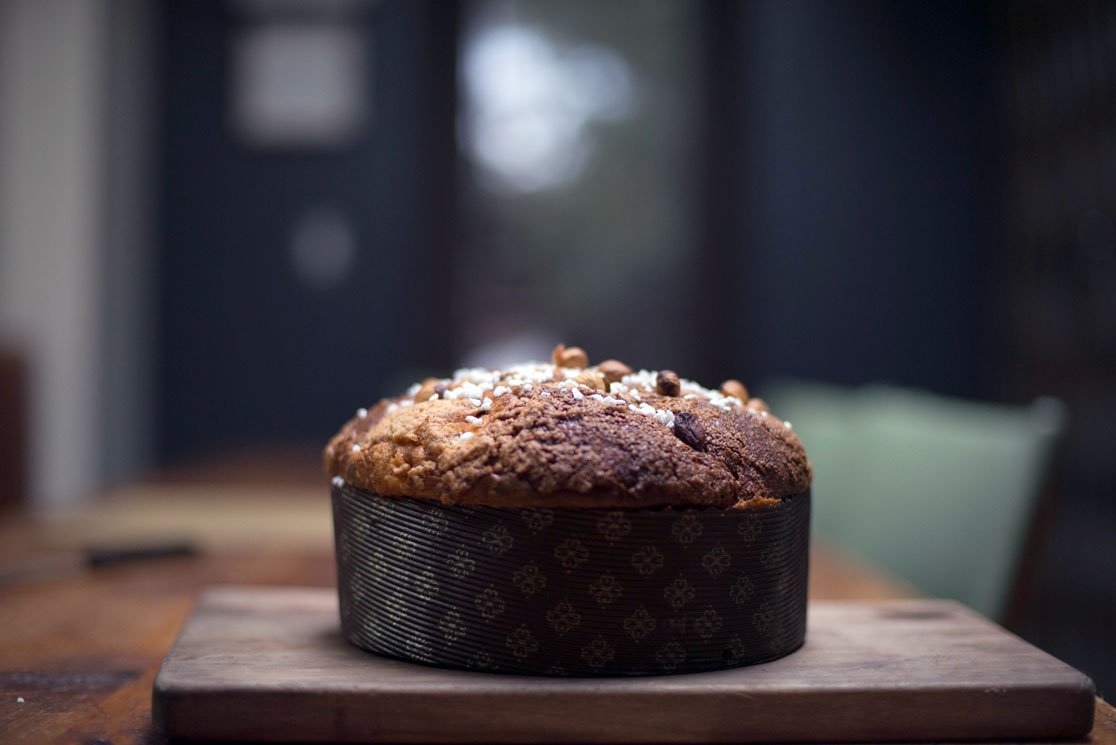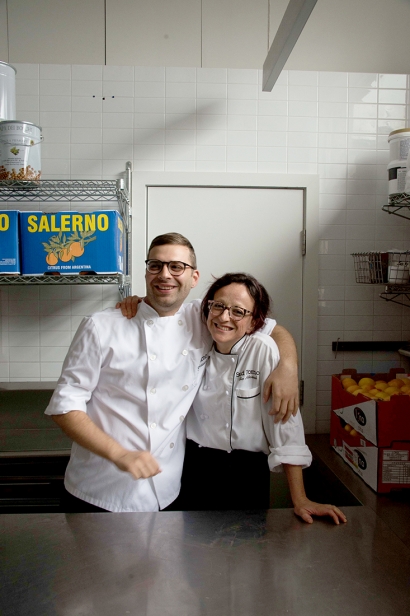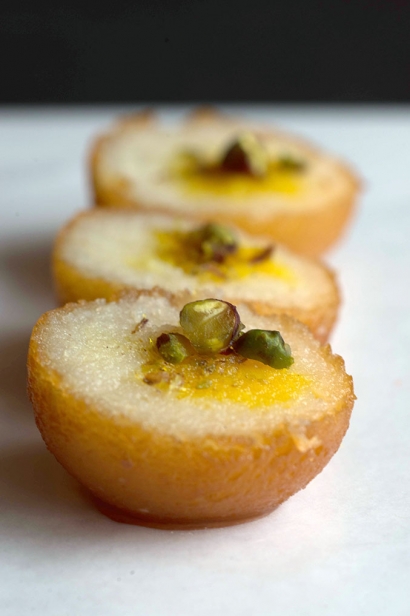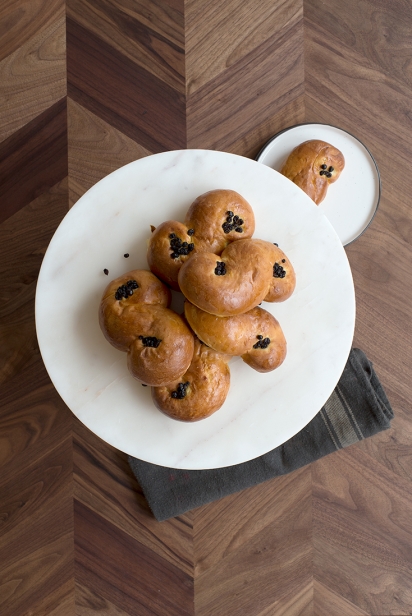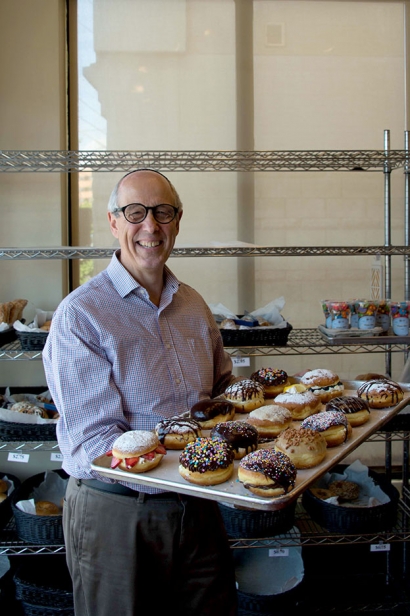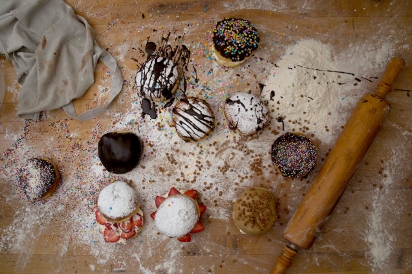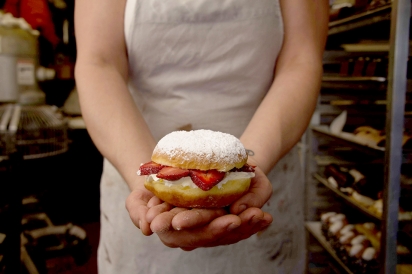Memories of Home
From Christmas and Diwali, to Chanukah and St. Lucia day, the holidays often share one thing in common — friends and family coming together around the table to celebrate over good food, drink and decadent treats.
For each person, the holiday dessert plate means something different and evokes a certain memory from childhood, of home and of family. Food traditions transcend oceans and time, no matter what continent or what country you’re from. Through the lens of Toronto chefs and bakers, here’s a tour of holiday sweets from around the world.
ITALY: PANETTONE
The time it takes to prepare one of Italy’s favourite Christmas breads is worth the wait.
You’ve seen versions of panettone in grocery stores at Christmas time. The tall, cylindrical loaf is a rich sweet bread, often studded with dried fruit or chocolate. It originated in Milan, two centuries ago and is now ubiquitous on Italian tables at Christmas and New Year celebrations.
“The opening of the panettone on Christmas Eve is a very special moment, a ritual,” Sud Forno’s executive chef Giovanna Alonzi explains. Every family has its own favourite type — “children always love the chocolate one,” says Alonzi, a self-taught chef who originates from Lazio, Italy, adding that adults tend to indulge in classic panettone, embracing its sweet nuances of chocolate and orange.
But don’t be fooled by the imported-straight-from-Italy status of the boxed stuff at the store, Alonzi warns. The real thing, freshly baked, made from mother yeast (akin to sourdough starter) and good ingredients, is worth the trip to an authentic Italian bakery. Panettone should be at once light and airy, but also rich and complex.
“All of the ingredients we use are vigorously selected,” Alonzi says, who has been with Sud Forno’s parent company (the Terroni group of restaurants) for more than 15 years.
“The flour that we use is milled for us, we import the best Italian candied orange and dark chocolate from Domori. We make it with mother yeast, fresh eggs and butter and it has no preservatives. The resulting panettone is very particular — you can taste the mother yeast, bourbon vanilla and all of those amazing ingredients,” she says. “Grocery store panettone lasts a year, uses preservatives and most use chemical yeast. Store bought panettone is usually made months ahead of Christmas; ours is produced days before.”
The process of making panettone is hard-learned. First, the mother yeast must be strengthened. Its usual feeding of flour and water is increased leading up to the holidays' prime baking period.
“Our head baker Luca Rotatori feeds it water and flour more often than normally and gives it a lot of love,” Alonzi says. “We call it Turiddu and during the Christmas holiday we take care of it like a baby.”
Making panettone the right way is something that is passed on from one baker to the next. “My favourite memory of panettone is when I first made it with our master baker Giuliano Pediconi. The whole process still seems like a dream to me,” Alonzi says.
“It is magical from the moment you begin preparing the mother yeast … to the kneading and shaping of it … to the moment when you pull it out of the oven to hang it and finally, taste it. The smell and taste from that first experience will always be in my heart.”
If you pick up a panettone, consider how you will serve it. “At the bakery we love to eat it on its own with a nice glass of Franciacorta (sparkling wine from the Lombardi region)," Alonzi says. "At the restaurant we often serve it with chocolate and zabaglione (an Italian custard-like dessert) on festive Christmas platters.”
Sud Forno
716 Queen St. W., 132 Yonge St., Toronto, Ont.
terroni.com/sud-forno | 416.504.7667 | @sudforno
MEXICO: TAMALES DE DULCE
A common Mexican dish transforms itself into a sweet indulgence for Christmas.
Many are familiar with the tamale — a masa dumpling, filled with cheese, meat or chilies, wrapped in a corn husk or plantain leaf, then steamed. But for Julio Guajardo, chef at Quetzal restaurant, it’s the sweet stuff that really hits the spot at Christmas time.
Tamales de dulce feature milk, butter and vanilla beans, as well as fruit such as guava, which gives the tamale a tell-tale pink hue. Guajardo loves the combination of sweetened corn and fruit. “The aroma fills a room as you steam them and everyone wants some!” he says. His own personal touch to tamales de dulce is a filling of cajeta — a goat’s milk caramel.
This traditional dessert has a long history, stretching further back than the arrival of Christianity in Mexico. “Corn was a very important crop in Mesoamerica, with the belief that people were created from corn,” explains Guajardo, who opened Quetzal with Grant Van Gameren, Kate Chomyshyn (Guajardo’s wife) and Owen Walker earlier this year.
“Tamales, because they are wrapped in corn husks, became an important part of ritual offerings. They can also be seen as a symbol of the Virgin Mary, carrying the baby Jesus or a mother carrying a future life. As a tradition, families get together to make tamales to then share with other people.”
It’s a tradition that brings Guajardo right back home to Mexico City, where he worked in his dad’s taquería. “The first time I made tamales was with a lady who used to work in the kitchen at the taquería. Her name was Francisca,” Guajardo remembers. “To be honest, she made them — and I made a mess.”
The big mess aside, those tamales were more than just a dessert for Guajardo. “We always shared sweet tamales with all my cousins and my extended family during the holidays. It was the only time of year I got to see them all at once,” recalls Guajardo, who is also behind Toronto’s Mexican restaurants Rosalinda and El Rey. “We smashed piñatas and sang Christmas carols.”
He says he’s perfected the dessert since. It’s “all about the consistency of the dough before you cook them," Guajardo says. It can't be too dry or too wet — there's a sweet spot right in the middle for nice, fluffy tamales.”
Quetzal
419 College St., Toronto, Ont.
quetzaltoronto.com | 647.347.3663 | @quetzaltoronto
INDIA: MITHAI
For the Festival of Lights, traditional sweets shine bright
Diwali, also known as the Festival of Lights, is one of the biggest and most important holidays for Hindus, Jains and Sikhs around the world. Celebrated every autumn in the northern hemisphere (spring in the southern hemisphere), the five-day festival symbolizes the spiritual triumph of light over darkness and good over evil. During the celebration, people enjoy firecrackers with family and friends and decorate their homes and communities with bright candles and lanterns.
Hand-in-hand with the festivities are the traditional foods, and in particular, the desserts. They are commonly prepared in big batches and shared with relatives and well-wishers during the celebrations. While there are literally dozens of varieties, a few showstoppers make appearances at most family tables. Known collectively as mithai, these sweets are like small snacks, often milk-based, cooked with grains and deep-fried in ghee. Spices such as saffron, cardamom and cinnamon are common, as are ingredients such as coconut and dried fruit. Celebrants often save more expensive items, such as pistachios, for Diwali.
At Indian Rasoi, a family-owned gem in the heart of Toronto’s Little India neighbourhood, chef Mamta Verma prepares a variety of Diwali sweets, which draw people from all over the city. These desserts include gulab jamun, which are small balls of fried dough filled with pistachios and often topped with a cardamomrose water syrup. Another favourite is a sweet dumpling called gujiya, a treat filled with dried fruit and khoya (a popular Indian dairy product) and then pan-fried for a crispy, yet flaky, crust.
“At Diwali,” explains Chef Verma, “laddu is definitely the most popular.” To make this dessert, she fries small balls of dough made with chickpea flour, then soaks them in a sweet, saffroninfused syrup. “Not only is laddu both beautiful and tasty,” she continues, “but it is a dish mentioned throughout Hindu mythology and many Hindus also believe that it’s a favourite food of Lord Ganesha, a central deity.”
The secret to Chef Verma’s delectable treats? Her recipes are from back home in India and she always tries to maintain a true Indian taste — but with a little twist that will have all food lovers coming back for more.
Indian Rasoi
1437 Gerrard St. E., Toronto, Ont.
647.706.1994
SWEDEN: LUSSEKATTER
In the depths of December, Swedes celebrate the life of St. Lucia with candlelight and traditional saffron buns.
For Toronto pastry chef Logan Prong, what started out as a multi-stop Europe trip in 2011 turned into an extended stay in Stockholm, where he trained in different Swedish bakeries. This led to the discovery of the classic recipe for lussekatter or Swedish saffron buns, a sweet, eggy, saffron-flecked pastry commonly served for the annual Feast of St. Lucia.
The holiday buns have been a tradition in Sweden for centuries, resulting in a multitude of origin stories. One of the most common histories pays tribute to St. Lucia, who was known for secretly bringing food to persecuted Christians hiding in the Roman catacombs. Travelling through the dark tunnels, she would wear a wreath lit with candles on her head, leaving both hands free to carry food. When Christian missionaries came to Scandinavia, the story of a kind girl, whose name means light, and who shared warmth and sustenance with others, held much appeal to a people who dealt with long, dark winters.
Traditionally, on the morning of December 13th, the oldest daughter of the house wears a flowy, white dress and a crown of candles on her head, offering a tray of a hot drinks and saffron buns to her loved ones. While another belief credits the golden colour of the saffron buns with keeping the devil away, the story that can be agreed to by all is that the saffron buns celebrate the start of Advent and the eventual return of longer days.
For Prong, who now runs Parkdale’s Yummy Stuff Bakery, saffron buns are a thing of nostalgia. “Since my trip to Sweden, I’ll pull out this recipe on a chilly day that reminds me of fall in Stockholm,” he says. “The aromatic hint of saffron is warming after a day of walking through cool, foggy forests.”
The lussekatter served at Yummy Stuff every December are made from a classic enriched dough with the addition of fresh saffron. Prong lets the dough rest overnight to allow the yeast the opportunity to develop lactic acid and a rich, buttery taste. The only divergence from the classic recipe? Prong’s much-welcomed and warming twist is a light brushing of a boozy simple syrup spiked with spiced rum.
Yummy Stuff
1660 Queen St. W., Toronto, Ont.
yummystuff.ca I 416.531.9732 | @yummystuffbakery
ISRAEL: SUFGANIYOT
Fried in oil, the Chanukah donut is a treat for old and young.
For Daniel Grodzinski, of Grodzinski’s Bakery in North York and Thornhill, the sufganiyot — a staple sweet during Chanukah — is all you need. It’s a donut stuffed with jam, or as Grodzinksi puts it: “It’s made of everything in life that tastes fantastic and that any diet says will kill you. It’s high in sugar, oil and fat. It’s deep fried in oil and infused with jam.” It's then dusted with even more sugar. “What more could you want in life?” Grodzinski quips.
It’s no accident that sufganiyot is fried in oil. Like latkes, Chanukah observers eat it to celebrate the miracle of the oil that burned for eight days. The ubiquitous Chanukah donut has debated origins and there’s no certainty about who brought it to Israel. There’s an old Israeli folktale that says the donut took its name after Adam and Eve were expelled from the Garden of Eden and God cheered them up by feeding them sufganiyot. The word, when parsed to sof-gan-yud-hey, means the end of the garden of the Lord.
One thing is certain, the treat’s popularity is growing. Whereas in the past, it was difficult to find sufganiyot outside of the Chanukah season, they’re available nearly year-round these days. Its traditional strawberry-jam flavour has also been joined by dozens more, including custard, coffee, cream and other fruits.
Sufganiyot stirs up some sweet memories for Grodzinski, whose great-grandfather opened the first Grodzinski Bakery in London, England, in 1888. “When my youngest daughter was about four years old, we needed someone to help ‘jam’ the sufganiyot. We were desperately short of staff, so we commandeered her. We stood her on a box, showed her what to do and for two hours straight she jammed sufganiyot. Eventually my wife came to take her home to put her to sleep. She needn’t have bothered — my daughter was fast asleep in the back of the car long before they ever got home!”
Grodzinski Bakery
3437 Bathurst St., North York, Ont.
grodzinskibakery.com | 416.789.0785 | @grodzinskibakery


